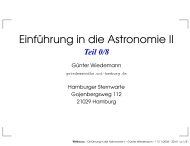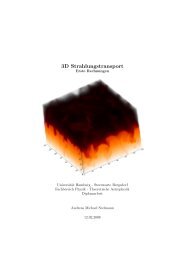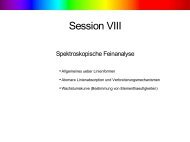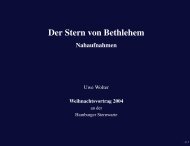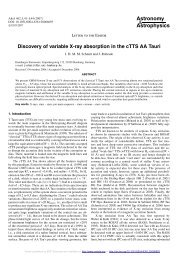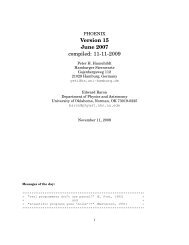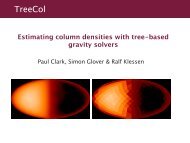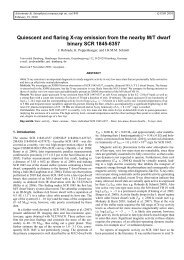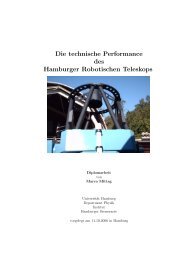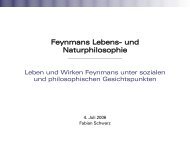Emmy Noether Application
Emmy Noether Application
Emmy Noether Application
You also want an ePaper? Increase the reach of your titles
YUMPU automatically turns print PDFs into web optimized ePapers that Google loves.
intensity field. Such approximations can be a flux limited diffusion approach (e.g. Yorke &<br />
Sonnhalter, 2002; Krumholz et al., 2007) which essentially averages the intensity field over<br />
all directions. This approach can also be extended with higher-order spherical harmonics to<br />
account for the main contributions of anisotropies.<br />
The radiation itself is emitted by the newly formed massive star or multiple stars. The PhD<br />
candidate should model these stars as luminous sources which vary with time. The model<br />
should be based on the evolution of pre-main-sequence and zero-age-main-sequence tracks<br />
from stellar evolution theory. A viable calculation of the stellar luminosity function is described<br />
in Yorke & Sonnhalter. (Helpful details can also be found in the book of Bodenheimer et al.,<br />
2006). Herein, the mass and radius of the central star is calculated based on a nuclear equation<br />
of state, mass accretion and mixing efficiency. The actual luminosity is then determined<br />
from previously published pre-main-sequence tracks; in this case the D’Antona & Mazzitelli<br />
(1994) calculations were used. It is expected that the radiation from luminous massive stars<br />
emit sufficient photons to photoevaporate the protostellar envelope and the circumstellar disc.<br />
The study of this process with a realistic description of the central massive star and radiation<br />
field should be the main effort of this part of the PhD project.<br />
Within this thesis project the PhD candidate should develop a realistic model for radiation<br />
feedback from young massive stars and study its influence on the formation of massive stars<br />
in isolation and clusters.<br />
First year<br />
As for the other PhD project, the PhD candidate should begin by getting familiar with the<br />
astrophysical processes which are operative in star formation. In particular, he or she should<br />
get a profound knowledge of radiative processes and approximate descriptions of them. The<br />
candidate should also early on get involved in performing numerical simulations of relevant<br />
problems. Again, when the PhD candidate has acquired the basic concepts of the physics<br />
and has gotten familiar with the structure of the code, he or she should start implementing<br />
a proper treatment of radiative processes. These processes should include photon-heating,<br />
photoionisation, dissociation of molecules, formation and destruction of dust grains, and cooling<br />
by collisional excitations of molecules and dust. This subproject should be based on the<br />
ray-tracing module by Rijkhorst et al. (2006) to calculate the photon induced processes and<br />
on the treatment of collisional cooling by Banerjee et al. (2006). Subsequently the candidate<br />
should adapt the ray tracing part so that multiple moving stars can be included in the calculations.<br />
This part of the numerical calculations should be verified with known solutions of test<br />
problems (e.g. Spitzer solution of a propagating ionisation front).<br />
Second year<br />
At the end of the first year into the project the PhD candidate should have completed the<br />
first part of the project drafted above and should now start to implement a realistic treatment<br />
of the radiation intensity and its interaction with the molecular gas and dust. This approach<br />
could be based on a flux limited diffusion approximation as outlined above and used in the<br />
two-dimensional calculations of Yorke & Sonnhalter (2002). Having the ray-tracing module,<br />
one can then use the consistently calculated optical depth to determine interaction efficiency<br />
between the photons and the gas. At the same time the candidate should implement a<br />
model for the time dependent luminosity of the massive star which is the source of the radiation<br />
field. The model again can be based on a similar approach described in Yorke &<br />
Sonnhalter (2002). After elaborate test calculations of the radiation field and stellar model<br />
the PhD candidate should publish this results in a scientific journal. As in the case of the<br />
other candidate, this will give him or her the chance to structure the collected works and<br />
20



